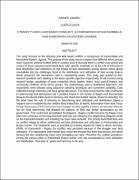| dc.description.abstract | The study focused on the ethnicity and land-based conflict: a comparison of Kachumbala and Kamonkoli Eastern Uganda. The purpose of this study was to compare how different ethnic groups share resources without conflict while in another area of diversity there is conflict over access and control of those resources particularly land, with specific emphasis on (i) the role of ethnicity in land distribution and utilization (ii) the impact of land distribution among diverse ethnic group coexistence (iii) the challenges faced in the distribution and utilization of land among diverse ethnic group.(iv) the mechanism used in maintaining peace. This study was guided by four research questions each relating to the above specific objective respectively. It was conduct using research design; population of study comprises ethnic leaders, elders, local council leaders, and community residents of the ethnic groups. The methodology used is Qualitative Approach. The respondents were selected using purposive sampling techniques and convenient sampling. Data collected through interview and focus group discussion. The study found that the role of ethnicity in determining land distribution had a positive impact in the border of Bagisu and Kachumbala because the diverse tribes lived in harmony and shared the limited natural resources amicably. On the other hand the role of ethnicity in determining land utilization and distribution played a negative part in heightening the conflict along tribal lines of hatred. Information from both Focus Group Discussions (FGD) and interviews brought out that Uganda’s history reveals that ethnicity has for long determined and dictated the patterns of land and border demarcation by the government. This could have precipitated the Bagwere –Bagisu conflict because the Bagisu have been very conscious of ensuring that their land was not robbed by the neighboring Bagwere while on the Kamonkoli border such a feeling has never been nurtured. The (FGD) found that there was no conflict related to ethnic settlements and land distribution and utilization in Kachumbala and Bugisu border. The inhabitants were in peaceful co-existing despite the tribal or ethnic diversity. While, In Kamonkoli - Bugisu the conflict was persistent because of the struggle over land utilization. The respondents interviewed gave views that showed that there was tension and hatred because the two neighboring tribes were wrangling over land. Therefore the conflict prevalence among the various tribes in Kamonkoli-Bugisu border area was orchestrated by land utilization and distribution. Thus lack of peace and harmony in the area. | en_US |

